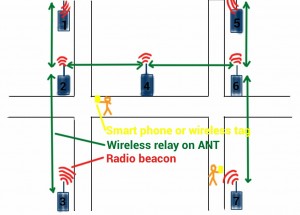Indoor locating of a smart phone by Bluetooth Low Energy (e.g. iPhone or Android phone)
Locating of smart phones like an iPhone or Android phone can be done with an app on the device. The app will download the floor plan of the building. Google maps already offers a floor plan generator. Nevertheless such an app will measure the signal strength of RF signals close by. Such signals are transmitted by WIFI routers or the cellular base stations. In public buildings like railway stations or airports you will find a lot of cellular base stations. The coverage goes down to micro cells with a radius of a few meters only. At a rail or at McDonalds you will find a lot of people using their phones. The only option to handle a huge number of phone users staying at the same place is running a micro cell. Anyhow, at such a location you will find a mix of micro cells, mini cells and WIFI routers as well. All this RF signals can be used for a triangulation. But what to do in a town hall, school or museum where you have no cellular cells or WIFI routers indoor? The new Bluetooth specification called Bluetooth Low Energy (BT 4.0, BT Smart) will help to install further RF beacons on low power consumption easy. These Bluetooth Low Energy radio beacons can be used for triangulation as well. The more Bluetooth Low Energy radio beacons you spend the more accurate the result will be. With optimized algorithm and Kalman filters the result can be optimized again. Smart phones of today have more calculation like the server of the indoor locating project at the World Trade Show Expo 2000 in Hannover. The EXPO 2000 was an indoor locating based on GSM cells up and was running. The other great news is that such a Bluetooth Low Energy radio beacon can run on solar or an a standard battery or a mix of both. If you do it right, the Bluetooth Low Energy beacon will run endless.
The further great news is that such Bluetooth Low Energy radio beacons are already in process. I consult the development of the Bluetooth Low Energy radio beacon and can help with the source as well. The project at EXPO 2000 I know very well because I was the project leader. A part of the algorithm was based on my ideas. Today I consult and guideline more than 10 indoor locating / detecting projects in parallel. It is allowed for me to make some of the project step by step public.
If you plan an indoor locating application please do not hesitate to drop an email to harald.naumann (at) gsm-modem.de.
